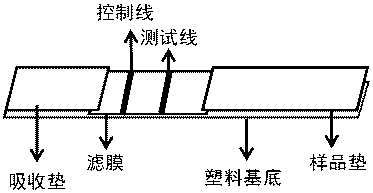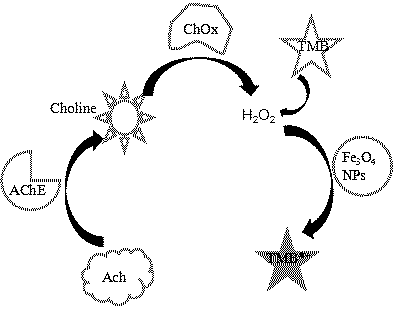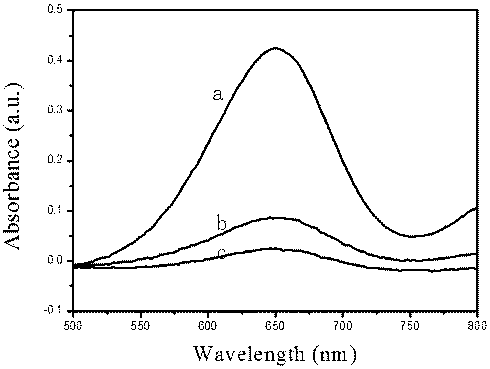A kind of acetylcholine detection test strip and its application
A technology for acetylcholine and detection test paper, which is applied in the field of analytical chemistry and biomedicine, can solve the problems such as detection of small molecules of nano-enzymes, unknown mechanism, etc., and achieves the effects of improving stability and simplifying preparation steps.
- Summary
- Abstract
- Description
- Claims
- Application Information
AI Technical Summary
Problems solved by technology
Method used
Image
Examples
Embodiment 1
[0036] Preparation of test strips:
[0037] (1) Add 10% BSA, 1 mmol / L NHS, and 0.5 mmol / L EDC mixture dropwise onto the nylon filter membrane (BSA is used to improve the adsorption capacity of the nylon filter membrane and serve as a template for the next reaction, EDC / NHS is to activate the carboxyl group on BSA), after incubating at room temperature for 30 min, washing and drying;
[0038] (2) Add 4 mmol / L of FeCl 3 solution, 2 mmol / L FeCl 2 Equal volumes of the solution and 16 mmol / L ammonia water were sequentially dispersed onto the nylon filter membrane adsorbed with BSA template obtained in step (1), incubated for 1 h and dried at room temperature, thereby generating the following in situ on the filter membrane. Fe3O4 nanoparticles (Fe 3 o 4 NPs), flushing out unreacted FeCl 3 , FeCl 2 and ammonia, then dry at room temperature;
[0039] (3) Add a certain concentration of AChE and ChOx dropwise to step (2) to generate Fe 3 o 4 @BSA NPs were incubated on the nylo...
Embodiment 2
[0044] The detection strip in the test strip has the activity of AChE, ChOx and imitation peroxidase under weakly acidic conditions, AChE can catalyze ACh to generate choline, and ChOx can catalyze choline to generate H 2 o 2 , the mimic peroxidase catalyzes H 2 o 2 A color reaction occurs with an organic chromogenic agent, and the detection schematic diagram is shown in the appendix of the manual. image 3 .
[0045] Detection band activity verification:
[0046] Experimental system a: The catalytic reaction system is a sample solution containing ACh (0.1 mmol / L), the detection band obtained in the above example (0.2×0.5 cm), organic chromogen TMB (0.5 mmol / L) and acetate Buffer (pH 4.0, 100mmol / L). After immersing the detection strip in the buffer solution containing ACh and TMB to react for 5 minutes at room temperature (25°C), remove the detection strip, and use a UV spectrophotometer to detect its absorbance within 500-800 nm, ( The organic chromogen used in the rea...
Embodiment 3
[0050] pH optimization of detection bands:
[0051] The catalytic reaction system is: sample solution containing ACh (100 μmol / L), detection strip (0.2×0.5 cm), organic chromogenic agent TMB (0.5 mmol / L) and buffer solutions of different pH (pH 1.0−2.0, Glycine-HCl buffer; pH 3.0−6.0, acetic acid-sodium acetate buffer; pH 6.5−8.0, phosphate buffer; pH 9.0−10.0, Tris-HCl buffer; pH11.0−12.0, sodium bicarbonate-hydrogen sodium oxide buffer). After reacting at room temperature (25°C) for 5 minutes, the detection band was taken out, and the absorbance value of the reaction solution at 650 nm was detected with a microplate reader. As attached to the manual Figure 5 As shown, the detection bands exhibited three-enzyme activity at acidic pH (pH 3.0−6.0), and the optimum pH was around 4.0.
PUM
 Login to View More
Login to View More Abstract
Description
Claims
Application Information
 Login to View More
Login to View More - R&D
- Intellectual Property
- Life Sciences
- Materials
- Tech Scout
- Unparalleled Data Quality
- Higher Quality Content
- 60% Fewer Hallucinations
Browse by: Latest US Patents, China's latest patents, Technical Efficacy Thesaurus, Application Domain, Technology Topic, Popular Technical Reports.
© 2025 PatSnap. All rights reserved.Legal|Privacy policy|Modern Slavery Act Transparency Statement|Sitemap|About US| Contact US: help@patsnap.com



